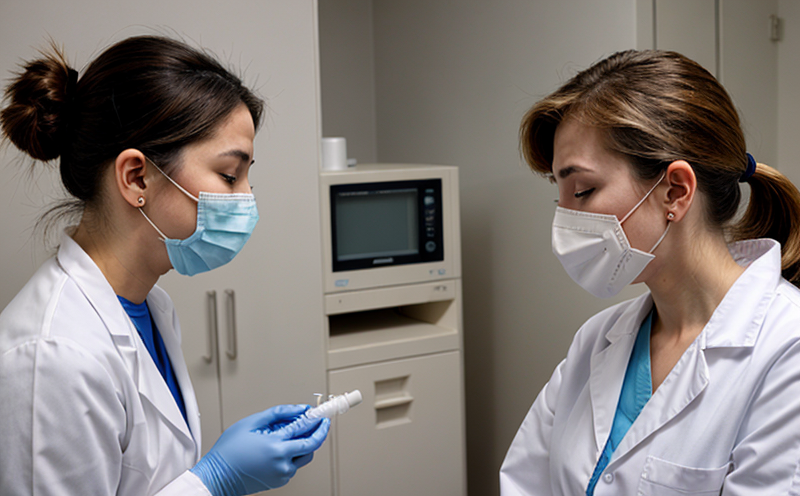Pollen Allergen Testing in Outdoor Air Monitoring
Pollen allergen testing in outdoor air monitoring is a critical tool used to assess and manage environmental factors that can trigger allergic reactions. This service involves the systematic collection, analysis, and interpretation of airborne pollen data to identify potential allergy triggers for individuals with sensitivities such as hay fever or asthma. The process ensures the accuracy and reliability of test results by adhering to stringent quality assurance protocols.
The primary goal of this testing is to provide actionable insights that can help in the development of effective management strategies, including the creation of pollen forecasts, public health advisories, and personalized treatment plans for allergy sufferers. By leveraging advanced technologies and methodologies, our lab ensures precise measurement and accurate reporting of pollen counts.
Our service focuses on several key aspects: sample collection, laboratory analysis, data interpretation, and client reporting. Sample collection involves the use of specialized air samplers positioned strategically across various locations to capture representative samples of outdoor air. These samples are then transported under controlled conditions to our state-of-the-art laboratory for detailed examination.
Laboratory analysis employs high-resolution microscopy techniques and immunoassay methods to quantify specific pollen types present in the collected samples. This multi-faceted approach ensures comprehensive identification and quantification of allergenic pollens, which are then compared against established reference standards (ISO 14642:2018).
Data interpretation involves translating raw data into meaningful insights that can inform public health decisions. Our team uses statistical models to predict future pollen levels based on historical data and current trends. These predictions help in the early detection of high-risk periods, allowing for timely interventions such as public advisories or enhanced monitoring efforts.
Client reporting is designed to provide clear, concise, and actionable information tailored to specific needs. Reports include detailed summaries of pollen types detected, their concentrations, and forecasts for upcoming seasons. This information is invaluable for healthcare providers, environmental planners, and individuals seeking to manage their exposure to allergens effectively.
In summary, our pollen allergen testing service offers a robust framework for understanding and mitigating the impact of airborne allergens on public health. By combining advanced analytical techniques with comprehensive reporting, we empower stakeholders to make informed decisions that enhance quality of life and promote environmental stewardship.
Scope and Methodology
The scope of pollen allergen testing in outdoor air monitoring encompasses the entire process from sample collection to final reporting. This section outlines the methodology employed to ensure accurate and reliable results.
Sample Collection: Air samples are collected using high-efficiency particulate air (HEPA) filters placed strategically across different geographical locations. These filters capture airborne particles, including various pollen types, which are later analyzed in our laboratory.
Laboratory Analysis: Once collected, the samples undergo rigorous analysis using both microscopic and immunoassay techniques. Microscopy allows for visual identification of pollen grains under high magnification, while immunoassays provide quantitative measurements of specific allergens present in the sample.
Data Interpretation: Collected data is processed through advanced statistical models to predict future trends and identify peak periods of pollen release. This information is essential for developing effective management strategies.
Client Reporting: Comprehensive reports are generated, detailing the types and concentrations of allergens detected, along with forecasts for upcoming seasons. These reports are designed to be easily understood by various stakeholders including healthcare professionals, environmental planners, and individuals affected by allergies.
Quality and Reliability Assurance
The quality of pollen allergen testing is paramount in ensuring accurate and reliable results. Our lab adheres to stringent quality assurance protocols at every stage of the process, from sample collection to final reporting.
Sample Collection: HEPA filters are regularly calibrated and maintained to ensure consistent performance. Field technicians undergo rigorous training to follow standardized procedures during sample collection.
Laboratory Analysis: Our laboratory is equipped with the latest analytical instruments, including scanning electron microscopes (SEM) and enzyme-linked immunosorbent assays (ELISA). These tools provide precise measurements of pollen counts and specific allergens. All analyses are conducted by certified professionals who follow established methods outlined in international standards such as ISO 14642:2018.
Data Interpretation: Statistical models used for data interpretation are validated against historical data to ensure accuracy. Predictions are continuously refined based on new data inputs, ensuring reliable forecasts of pollen levels.
Client Reporting: Reports are reviewed by senior scientists and edited for clarity and comprehensiveness. They undergo final checks to confirm compliance with quality standards before being disseminated to clients.
Use Cases and Application Examples
| Use Case | Description |
|---|---|
| Pollen Forecasts for Public Health Advisories | Pollinosis is a significant public health concern, especially during peak pollen seasons. By providing accurate forecasts, our service helps local authorities issue timely advisories to the general public. |
| Environmental Planning and Policy Development | Pollen monitoring data is crucial for environmental planning efforts aimed at reducing allergen exposure. This information supports policy development focused on urban greening initiatives and air quality improvements. |
| Patient Treatment and Management | Healthcare providers use our service to inform personalized treatment plans for allergy sufferers. Real-time data allows for adjustments in medication or avoidance strategies as needed. |
| Agricultural Impact Assessment | Pollen monitoring can help assess the impact of pollen on agriculture, particularly in regions where crops are sensitive to allergens. This data supports decision-making regarding planting schedules and pest management. |
| Research and Development | Scientists use our service to gather comprehensive data for research studies on pollen allergies, contributing to the development of new treatments and preventive measures. |





